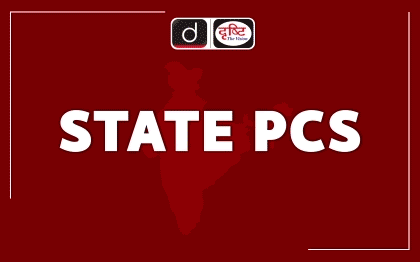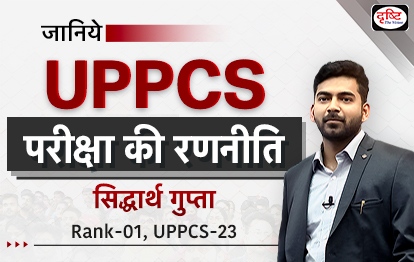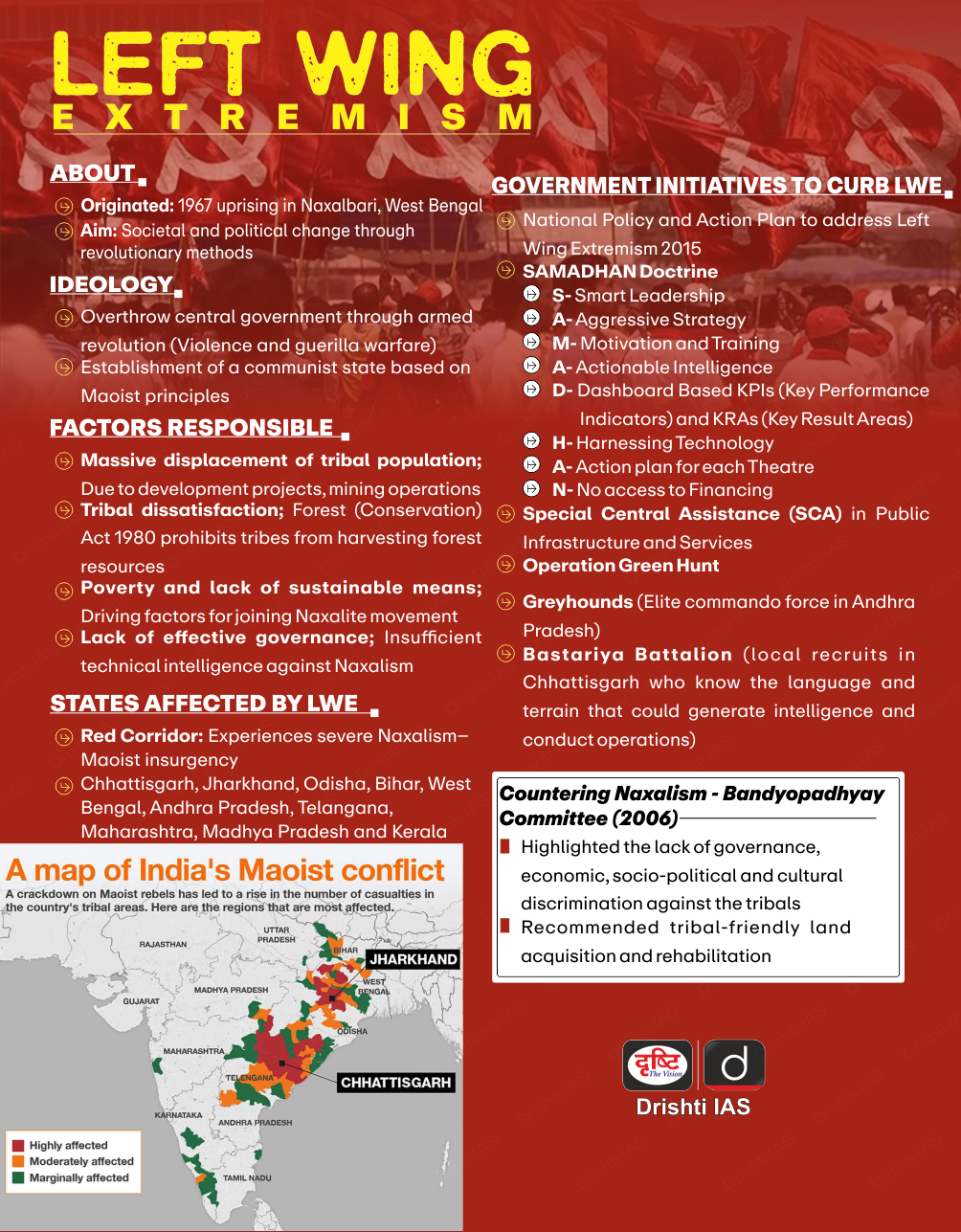Jammu & Kashmir Switch to Hindi
Unlawful Activities (Prevention) Act 1967
Why in News?
The government has banned ‘Jammu & Kashmir Ittihadul Muslimeen’ (JKIM) and ‘Awami Action Committee (AAC)’ as unlawful associations for five years under Section 3(1) of the Unlawful Activities (Prevention) Act (UAPA), 1967.
Key Points
- Ban on JKIM and AAC:
- Union Home Minister stated that these organizations incited unrest and posed a threat to India’s unity and integrity.
- Reasons for the Ban:
- Members of JKIM and AAC were found promoting separatism in Jammu & Kashmir.
- They engaged in anti-national and subversive activities, including:
- Spreading discontent among the people.
- Inciting unrest and destabilizing law and order.
- Supporting terrorism and fostering hatred against the government.
Unlawful Activities Prevention Act, 1967
- UAPA was passed in 1967. It aims at effective prevention of unlawful activities associations in India.
- Unlawful activity refers to any action taken by an individual or association intended to disrupt the territorial integrity and sovereignty of India.
- The Act assigns absolute power to the central government, by way of which if the Centre deems an activity as unlawful then it may, by way of an Official Gazette, declare it so.
- It has the death penalty and life imprisonment as the highest punishments.
- Under UAPA, both Indian and foreign nationals can be charged. It will be applicable to the offenders in the same manner, even if crime is committed on a foreign land, outside India.
- The investigating agency can file a charge sheet in maximum 180 days after the arrests and the duration can be extended further after intimating the court.
- The 2004 amendment added “terrorist act" to the list of offences to ban organisations for terrorist activities, under which 34 outfits were banned.
- Till 2004, “unlawful" activities referred to actions related to secession and cession of territory.
- In August, Parliament cleared the Unlawful Activities (Prevention) Amendment Bill, 2019 to designate individuals as terrorists on certain grounds provided in the Act.
- The Act empowers the Director General of National Investigation Agency (NIA) to grant approval of seizure or attachment of property when the case is investigated by the said agency.
- The Act empowers the officers of the NIA, of the rank of Inspector or above, to investigate cases of terrorism in addition to those conducted by the DSP or ACP or above rank officer in a state.


Chhattisgarh Switch to Hindi
New Maoist Rehabilitation Policy
Why in News?
On 12th March 2025, the Chhattisgarh Government approved a new rehabilitation policy for surrendered Maoists ensuring financial aid, education, employment, and security for them.
Key Points
- Approval of New Maoist Rehabilitation Policy:
- The Chhattisgarh Naxal Surrender/Victim Relief and Rehabilitation Policy-2025 replaces the 2023 policy.
- The policy offers financial aid, education, employment, and security to surrendered Maoists.
- Special schemes will assist in self-employment and skill development, ensuring reintegration into society.
- Victims of Maoist violence will receive support and rehabilitation.
- Establishment of State Water Informatics Centre (SWIC):
- The Cabinet approved setting up SWIC for scientific water resource management.
- An MoU will be signed with the Union Ministry of Jal Shakti for collaboration.
- SWIC will collect, analyze, and store data on rainfall, groundwater quality, reservoir levels, and more.
- The National Water Informatics Centre (NWIC) will support the initiative with a digital platform for policymaking and strategic decisions.
- Approval of Key Legislative Bills:
- Chhattisgarh State Industrial Security Force Bill-2025
- Chhattisgarh Cooperative Society (Amendment) Bill-2025
- Chhattisgarh Private University (Establishment and Operation) (Amendment) Bill-2025
- Launch of Chief Minister’s Good Governance Fellowship Scheme:
- The scheme aims to engage youth in governance and policy implementation.
- It will enhance good governance practices in the state.


Madhya Pradesh Switch to Hindi
Werewolf Syndrome
Why in News?
A teenager suffering from "werewolf syndrome" from Madhya Pradesh has created a Guinness World Record for the hairiest face.
Key Points
- Werewolf Syndrome:
- Werewolf syndrome, also known as hypertrichosis , is an extremely rare genetic condition, with only 50 cases reported worldwide so far.
- The condition causes excessive hair growth on certain parts of the body, especially the face.
- Types:
- Congenital Hypertrichosis:
- It is present from birth and is usually due to genetic causes.
- Scientists believe this is due to the reactivation of ancient dormant genes that were responsible for excessive body hair in early human ancestors.
- In this condition, a person may have excessive hair all over the body or on some specific parts.
- Acquired Hypertrichosis
- It develops after birth and is associated with external or internal causes.
- Possible reasons for this include:
- Certain medications, such as hair growth stimulants, androgenic steroids, and immunosuppressant drugs , can aggravate hypertrichosis.
- Certain cancer types and genetic variations may be linked to this condition.
- Certain skin infections and autoimmune diseases are also known to cause this condition.
- Nutritional deficiencies
- Eating Disorders
- Congenital Hypertrichosis:


Rajasthan Switch to Hindi
Skill Development Policy 2025
Why in News?
On 9th March 2025, the Rajasthan Cabinet approved the Rajasthan Skill Development Policy-2025 with the aim of promoting skill development of youth and employment generation in the state .
Key Points
- About the Policy:
- The aim of this policy is to train the youth according to modern industrial needs and provide them new employment opportunities.
- It seeks to accelerate industrial growth while preparing the workforce for global competition.
- Initiatives and features:
- Modernisation of Industrial Training Institutes (ITI):
- The state government will update the Industrial Training Institutes as per the latest requirements of the industry.
- This will include new curriculum, training modules and on-the-job training, giving the youth practical experience.
- Establishment of Model Career Centres:
- Model Career Centres will be established in all the divisional headquarters of the state, which will help connect the youth with career counselling, internships and employment opportunities.
- These centres will act as an important link between students and industries.
- Training in modern technologies:
- Under this policy, youth will be trained in modern technologies like Automation, Artificial Intelligence (AI), Machine Learning, Smart Manufacturing and Cyber Security.
- Local Industrial Cluster Training Centres:
- Local training centres will be set up in various industrial areas of the state to train workers according to the specific industrial requirements.
- This will provide skilled human resources to local industries and also increase employment opportunities.
- Reskilling and Upskilling:
- The policy will focus on upskilling and reskilling of workers and employees to enable them to adapt to the changing industrial environment and keep pace with new technological trends.
- Modernisation of Industrial Training Institutes (ITI):
Pradhan Mantri Kaushal Vikas Yojana (PMKVY)
- About:
- Skill India Mission was launched by the government in the year 2015, under which Pradhan Mantri Kaushal Vikas Yojana (PMKVY) was introduced.
- Objective:
- It aims to train more than 40 crore people in India in various skills by the year 2022 and to provide vocational training and certification to Indian youth for better livelihood and respect in the society.
- PMKVY is implemented by National Skill Development Corporation (NSDC) under the guidance of the Ministry of Skill Development and Entrepreneurship (MSDE) .


Uttar Pradesh Switch to Hindi
Taj Trapezium Zone
Why in News?
On 5th March 2025, the Supreme Court directed the Taj Trapezium Zone (TTZ) Authority to appoint the Forest Research Institute (FRI) to conduct a tree census in the zone .
Key Points
- Supreme Court Decision:
- According to the court, it is necessary to count the trees existing in the area to prevent any illegal felling.
- The court gave fresh directions that the purpose of the Uttar Pradesh Tree Protection Act, 1976 is to count and protect trees.
- Without tree census, the provisions of this Act cannot be effectively implemented.
- The court also upheld the need to obtain permission for cutting trees for agroforestry.
- In its 2015 judgment, the court had ruled that the provisions of the 1976 Act for agroforestry would continue to apply, which means that necessary permission would have to be taken before cutting any tree.
- About Taj Trapezium Zone:
- TTZ is a designated area of 10,400 square kilometres around the Taj Mahal to protect it from pollution.
- It is so named because it is located around the Taj Mahal and is shaped like a trapezoid.
- It contains many monuments, including the three World Heritage Sites,Taj Mahal, Agra Fort and Fatehpur Sikri .
- This includes Agra, Firozabad, Mathura, Hathras and Etah districts of Uttar Pradesh and Bharatpur district of Rajasthan.
- The area is divided into four zones based on the category of industries, namely red, green, orange and white.
- Only environment friendly, non-polluting small, tiny and micro scale industries may be allowed to operate in this zone.
- TTZ is a designated area of 10,400 square kilometres around the Taj Mahal to protect it from pollution.
Forest Research Institute (FRI)
- FRI is located in Dehradun, Uttarakhand. This institute started in the year 1878 as Forest School.
- In the year 1906, it was reestablished as the Imperial Forest Research Institute under the British Imperial Forestry Service . Later it was renamed as Forest Research Institute and College .
- It has many centres across the country, which carry out research as well as provide training to forest officers and forest rangers.
- After the reorganization of forestry research in the country and the creation of Indian Council of Forestry Research and Education (ICFRE ) in 1988, the training and research centers were given the status of independent institutions.
- The Forest Research Institute presently comes under ICFRE which was granted Deemed University status in December 1991.












%20MPPCS%202025%20Desktop%20E.jpg)
%20MPPCS%202025%20Mobile%20E%20(1).jpg)





















 PCS Parikshan
PCS Parikshan


